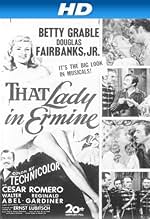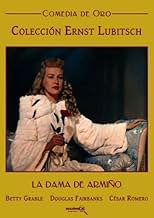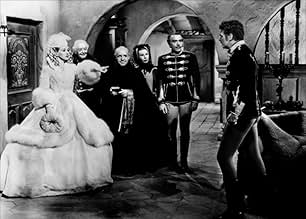IMDb RATING
5.8/10
973
YOUR RATING
That Lady in Ermine tells two parallel stories, both taking place in the small Mittel-European duchy of Bergamo, with one set in the 19th century and the other in the 16th.That Lady in Ermine tells two parallel stories, both taking place in the small Mittel-European duchy of Bergamo, with one set in the 19th century and the other in the 16th.That Lady in Ermine tells two parallel stories, both taking place in the small Mittel-European duchy of Bergamo, with one set in the 19th century and the other in the 16th.
- Directors
- Writers
- Stars
- Nominated for 1 Oscar
- 2 nominations total
Lester Allen
- Jester
- (uncredited)
Mary Bear
- Isabella - Ancestor
- (uncredited)
David Bond
- Gabor
- (uncredited)
Harry Carter
- Staff Officer
- (uncredited)
Harry Cording
- Orlando - Ancestor
- (uncredited)
Herbert Evans
- Ancestor
- (uncredited)
Jack George
- Count Giovanni - Ancestor
- (uncredited)
Don Haggerty
- Staff Officer
- (uncredited)
Joe Haworth
- Soldier
- (uncredited)
Ray Hyke
- Albert's Knight
- (uncredited)
- Directors
- Writers
- All cast & crew
- Production, box office & more at IMDbPro
Featured reviews
If you have the opportunity to catch this one on TV (It's in American Movie Classic's library, I believe, and doesn't appear to be available on video.) and you're a fan of Ernst Lubitsch, don't expect much evidence of his famous "Touch." Herr Lubitsch died before completing very much of this production and the directing reigns were turned over to Otto Preminger. Apparently the studio felt that an artist whose ancestral origins shared to some degree those of Mr. Lubitsch was the proper person to complete this project. My own impression of the final results makes the passing of the talented Mr. Lubitsch a great misfortune for all concerned. As I watched it on a TV broadcast several years ago I stared in amazement at what seemed an extraordinarily clumsy and heavy-handed attempt to tell what is, essentially, a fairy story for adults. There are definitely elements to enjoy and Betty Grable is, as always, appealingly lovely in Technicolor and has a lively and natural presence as an actress. But Mr. Preminger's reputation, without later critically praised films, such as "Anatomy of a Murder," was not greatly enhanced by the final cut of this film.
I really enjoyed this Lubitsch movie with Betty Grable. It made quite a change from her usual "musicals", and I cannot again understand why there have been no videos or DVDs made of it. Younger viewers who don't even know who Betty Grable is will surely appreciate this Lubitsch movie. Here's hoping!
I just watched this film on YouTube; it's there for free in version with very good image quality. It was a box office flop, and has a poor reputation among classic film devotees. But if you enjoy musicals, you might want to give it a chance.
I mildly enjoyed it. Fairbanks Jr. Is excellent, giving a spirtited performance with the right touch of believable emotion and light tungue in cheek playfulness. The sets are opulant. Fredrick Holander's music is lovely, though the song lyrics (by Leo Robin?) are mediocre and banal. There are occasional playfully funny moments.
On the down side, the film overall lacks the charm, subtle sexiness, and light touch that Lubitch would have given it, if he had directed the entire thing, and his capabilities were not greatly diminished by very poor health. Grable is OK in the role, but far from the ideal actress-singer for it. I've read that Fox head Zanick wanted to broaden her appeal and put her in more high class roles, so she made three classy pictures and all of them, including this one flopped. (One of them is excellent, and I highly recommend it, "The Shocking Miss Pilgrim".)
That Lady in Ermine seems to have two endings; and I felt let down by the second one. It should have ended when the Fairbanks character rides away, bidding the Grable character a regretful goodby. But then there's a entirely unnecessary scene, which seems tacked on.
I mildly enjoyed it. Fairbanks Jr. Is excellent, giving a spirtited performance with the right touch of believable emotion and light tungue in cheek playfulness. The sets are opulant. Fredrick Holander's music is lovely, though the song lyrics (by Leo Robin?) are mediocre and banal. There are occasional playfully funny moments.
On the down side, the film overall lacks the charm, subtle sexiness, and light touch that Lubitch would have given it, if he had directed the entire thing, and his capabilities were not greatly diminished by very poor health. Grable is OK in the role, but far from the ideal actress-singer for it. I've read that Fox head Zanick wanted to broaden her appeal and put her in more high class roles, so she made three classy pictures and all of them, including this one flopped. (One of them is excellent, and I highly recommend it, "The Shocking Miss Pilgrim".)
That Lady in Ermine seems to have two endings; and I felt let down by the second one. It should have ended when the Fairbanks character rides away, bidding the Grable character a regretful goodby. But then there's a entirely unnecessary scene, which seems tacked on.
Ernst Lubitsch's style permeates this unjustly forgotten movie, from a different age of cinema. Oddly enough, any old film noir (or just crime-oriented) feature from its age is revered on a pedestal today, while this wonderful 20th Century-Fox big-budget effort stirs little interest.
It is a remake of a 1927 silent film of the same title, a Corinne Griffith star vehicle from First National Pictures, the distributor that later became part of Warner Brothers. It's a lost film, perhaps because a silent movie of an operetta was hopelessly dated even then. Lubitsch includes fantasy and satire here, with the play-acting performances of stars Grable and Fairbanks delightful in that they make fun of the antiquated Period Costume Film cliches, while simultaneously creating warm and empathetic characters. The elements of satire have given way in modern cinema to vulgarity, as evidenced in the work of Mel Brooks (who remade Lubtisch's hit "To Be Or Not to Be") or my favorite director Ken Russell, yet Lubitsch is able to maintain the high ground even in the silliest of scenes, perhaps aided by the censorship of his day.
The Technicolor photography (by Leon Shamroy) remains stunning and just what any film buff should admire. A couple of oddities struck me as I finally saw this movie, so many decades after release, first the foot-fetish theme that instantly suggests Luis Bunuel, who was working in Hollywood during this period. And by some odd coincidence, the starting point for the movie's fantasy element is the stunning portrait of Gable as a 17th Century ancestor of her main character, which comes to life occasionally. Fairbanks' infatuation with the lady in the portrait is the same starting point as Preminger's greatest movie, "Laura", and Otto ended up completing "Ermine" after Lubitsch's sudden death at the age of 55.
It is a remake of a 1927 silent film of the same title, a Corinne Griffith star vehicle from First National Pictures, the distributor that later became part of Warner Brothers. It's a lost film, perhaps because a silent movie of an operetta was hopelessly dated even then. Lubitsch includes fantasy and satire here, with the play-acting performances of stars Grable and Fairbanks delightful in that they make fun of the antiquated Period Costume Film cliches, while simultaneously creating warm and empathetic characters. The elements of satire have given way in modern cinema to vulgarity, as evidenced in the work of Mel Brooks (who remade Lubtisch's hit "To Be Or Not to Be") or my favorite director Ken Russell, yet Lubitsch is able to maintain the high ground even in the silliest of scenes, perhaps aided by the censorship of his day.
The Technicolor photography (by Leon Shamroy) remains stunning and just what any film buff should admire. A couple of oddities struck me as I finally saw this movie, so many decades after release, first the foot-fetish theme that instantly suggests Luis Bunuel, who was working in Hollywood during this period. And by some odd coincidence, the starting point for the movie's fantasy element is the stunning portrait of Gable as a 17th Century ancestor of her main character, which comes to life occasionally. Fairbanks' infatuation with the lady in the portrait is the same starting point as Preminger's greatest movie, "Laura", and Otto ended up completing "Ermine" after Lubitsch's sudden death at the age of 55.
Watched 'That Lady in Ermine' as an admirer of both Otto Preminger and Ernst Lubitsch and as a fan of classic-era film. It is hard to go wrong too with performers such as Betty Grable, Douglas Fairbanks Jr and Caesar Romero on their own and just as big a delight seeing those names in the same film and there was an intriguing story and ideas here.
Ideas that could have been executed much better on the whole. 'That Lady in Ermine' is far from a bad film and there is a good deal to like, but it is very uneven, quite strange and doesn't really come together as an overall whole. While the talent and potential are not completely squandered they are nowhere near close to being fulfilled, all have done much better and deserved better.
Starting with the good things, 'That Lady in Ermine' does look great. It is very lavishly produced and shot in beautiful, vibrant Technicolor. The music is pleasant and charming regardless of its lack of memorability. There are elements of the Lubitsch touch, where there is sparkling wit, sophistication and charm and where the film has more energy.
Despite her later considering 'That Lady in Ermine' her least favourite film of her career, Betty Grable is spunky and charming, it is not a typical role for her but her approach to it is distinctively so. Romero and especially Fairbanks are immensely likeable in their roles and Walter Abel, Harry Davenport and Reginald Gardiner entertain in support.
However, the story is both slight, plot-less often, and overly silly, with a lot of ideas not done anywhere near much with and too many elements that don't gel together. The script is uneven, sometimes witty and at other times clunky and the pace is a mix of just fine to dull in other stretches. The final act is somewhat heavy-handed which jars with a good deal of the rest of the film.
As has been said, this was Lubitsch's last film and mostly his but he sadly died of a heart attack aged 55 during filming and the film was completed by Preminger. Some may say that the transition from one to the other was seamless, personally do not agree with this. The two had very different directing styles to each other and approached their films differently, Lubitsch's films were light, sophisticated and witty while Preminger's were heavier and some exploring darker and ahead of the time themes and subjects, both as great and absorbing as each other in their own way. Both styles can be seen here and don't gel together, with Lubitsch's style being more successful in his own distinctive way and far more enthusiastic while Preminger's was heavy-handed and coarse which is where the film is less interesting.
Overall, uneven but oddly interesting and watchable. 5/10 Bethany Cox
Ideas that could have been executed much better on the whole. 'That Lady in Ermine' is far from a bad film and there is a good deal to like, but it is very uneven, quite strange and doesn't really come together as an overall whole. While the talent and potential are not completely squandered they are nowhere near close to being fulfilled, all have done much better and deserved better.
Starting with the good things, 'That Lady in Ermine' does look great. It is very lavishly produced and shot in beautiful, vibrant Technicolor. The music is pleasant and charming regardless of its lack of memorability. There are elements of the Lubitsch touch, where there is sparkling wit, sophistication and charm and where the film has more energy.
Despite her later considering 'That Lady in Ermine' her least favourite film of her career, Betty Grable is spunky and charming, it is not a typical role for her but her approach to it is distinctively so. Romero and especially Fairbanks are immensely likeable in their roles and Walter Abel, Harry Davenport and Reginald Gardiner entertain in support.
However, the story is both slight, plot-less often, and overly silly, with a lot of ideas not done anywhere near much with and too many elements that don't gel together. The script is uneven, sometimes witty and at other times clunky and the pace is a mix of just fine to dull in other stretches. The final act is somewhat heavy-handed which jars with a good deal of the rest of the film.
As has been said, this was Lubitsch's last film and mostly his but he sadly died of a heart attack aged 55 during filming and the film was completed by Preminger. Some may say that the transition from one to the other was seamless, personally do not agree with this. The two had very different directing styles to each other and approached their films differently, Lubitsch's films were light, sophisticated and witty while Preminger's were heavier and some exploring darker and ahead of the time themes and subjects, both as great and absorbing as each other in their own way. Both styles can be seen here and don't gel together, with Lubitsch's style being more successful in his own distinctive way and far more enthusiastic while Preminger's was heavy-handed and coarse which is where the film is less interesting.
Overall, uneven but oddly interesting and watchable. 5/10 Bethany Cox
Did you know
- TriviaIn later years Betty Grable said it was her least favorite of all her movies.
- GoofsIf you watch when the Lady in Ermine is dancing with Colonel Ladislas Karolyi Teglas / The Duke her shoes change from the heels to wedges.
- Quotes
Col. Ladislas Karolyi Teglas: If one is in love, one doesn't need an umbrella.
- ConnectionsFeatured in The Costume Designer (1950)
- SoundtracksOoh! What I'll Do (To That Wild Hungarian)
(uncredited)
Written by Friedrich Hollaender
Lyrics Leo Robin
Sung by Betty Grable and chorus
Danced by Betty Grable and Douglas Fairbanks Jr.
- How long is That Lady in Ermine?Powered by Alexa
Details
Box office
- Budget
- $2,484,000 (estimated)
- Runtime
- 1h 29m(89 min)
- Color
- Aspect ratio
- 1.37 : 1
Contribute to this page
Suggest an edit or add missing content

































